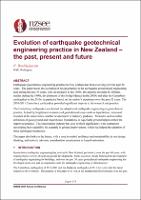Impact of Canterbury earthquakes on the evolution of earthquake geotechnical engineering practice
Abstract
Earthquake geotechnical engineering practice has evolved in New Zealand during the past 40 years. The 2010-2011 Canterbury earthquakes provided significant impetus to the research and practice.
Early evolution commenced with research at the Canterbury University and Ministry of Works into the earthquake earth pressures and publication of the RRU Bulletin in 1990. This was followed by development of geotechnical design standards for the Bridge Manual including the use of reinforced soil walls for the Bridge Manual. This ensured the application on highway projects since the early 2000s. The lifelines groups highlighted the risks to critical lifelines facilities which has meant that understanding of the earthquake geotechnical hazards grew significantly since the early 1990s with the development of earthquake hazard maps including for liquefaction and earthquake induced landsliding starting with the series developed for Wellington. This also grew into its use in planning including land use planning since the late 1990s.
The 2010-2011 Canterbury earthquakes accelerated the adoption of earthquake engineering in geotechnical practice, helped by heightened awareness of geotechnical issues such as liquefaction, increased research at the universities, and the development of the MBIE guidance. The earthquakes helped enhance engineering practice in the building industry in Christchurch and elsewhere[BP1] . This including measures such as better definition of good ground and research into foundations in liquefiable ground helped embed the improved practice. The construction industry has also evolved significantly with contractors developing their capability for example in ground improvement, which has helped the adoption of these techniques in practice.

